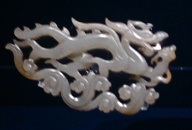chinese jade
Shanghai Museum
Shanghai, east Central China
October 16 & ,17 2009


chinese jade
Shanghai Museum
Shanghai, east Central China
October 16 & ,17 2009


China’s rich history of jade carving, with 8,000 years of artistic craftsmanship, has enjoyed a reputation for being the “Home of Jade”. Jade carving is the oldest tradition of the Chinese crafts, thought of as a unique and glorious art, the “blossom of the oriental art”. In ancient times, rulers believed that jade was the symbol of wealth and power, intrinsically imbued with mystical allure and beauty. Used for objects of personal adornment, sacrificial ritual implements, and burial objects, jade was thought to hold the power to avert evil spirits. As early as the the Pre-historic period, jade workmanship had reached a highly technical level which included: selection of stones, design and decoration, and cutting and polishing. Between 6000 and 2000 BC, strong regional features appeared in jade pieces. Because their production required a great deal of skilled labor and a high degree of specialization, jade carving became an expression of the “dawn of Chinese civilization” whereby only tribal chiefs and shamans could own objects of jade. Between 2000 and 771 BC, ritual jade pieces were fully developed during the Xia, Shang and Western Zhou dynasties. The rulers of this period used ritual jade to consolidate their power. Sets of new ritual jades appeared as well as those inherited from the pre-historic past. Ornamental jades appeared in some profusion. Carved in animal or mythological figures, sometimes combined with the human figure in complex shapes. By this time, jade ornaments had become a fashionable accessory of the nobility, a mark of gentlemanly distinction. According to the artistic fashion of the times, the carvings were stylized & elegant. In the period between 770 and 221 BC, against a background of social change and economic progress in the Spring & Autumn Warring States periods, Chinese jade s entered a transitional phase. To meet the needs of a new society, new varieties of jade were created one after another. Ritual jades ceded their dominance to ornamental pieces, with sets of jade pendants made up of differently sized and shaped components gaining much popularity. Belt hooks and sword ornaments appeared in considerable numbers. In decoration, interlocked dragon motifs prevailed in unusual and varied designs, all distinguished by fine workmanship and romantic spontaneity. Though the craft diminished in importance during the Eastern Han and Northern and Southern dynasties. By the Tang and Song dynasties 618-1279 AD, jade had moved beyond courtly ritual to became more widespread in society, becoming utilitarian in everyday objects as well as personal possessions and curios. The design repertoire was extended as animal, flower, bird, or mountain grove motifs gained in popularity. Engravings of figures of musicians on Tang jade belt plaques reflected contemporary cultural exchanges between China and foreign countries. Song Dynasty jade ornaments shaped like flowers or birds, or in the form of a child holding a lotus flowers imparted the flavor and fashion of the time. During the Yuan Dynasty, 1279-1348 AD jade carving continued to evolve and flourish; and, in the years of the Ming Dynasty, 1348-1644 AD, jade pieces became extremely complex and ornate, with deep carving of exceptional beauty. By the Qing Dynasties, 1644-1911 AD, the popularity of jade had reached a much larger segment of society, where the desire to own personal objects, especially jade jewelry (considered to have special healing properties) remains popular today.
Process of Jade Carving: Throughout history, the beginning of jade artistry began with the selection of the stone, the size and colorations often inspiring the design of the object. Next, the outline of the design was cut. The hardness of jade require a harder material to cut the stone. Pre-historic jade carvers used flint, obsidian, crystal, agate, bones, or saws of wood to cut the shape from the stone. They also used animal tendons to aid in cutting. With human evolution and the invention of metal, jade was cut, carved and polished using a special machine called the shuideng, or water bench. Ming Dynasty paintings document the craft of jade carving, where metal discs were attached to rods engineered by ropes and manually powered by foot treadles to cut the stone. A mixture of grains of various minerals, quartz, emery, and garnet, all harder than jade, were combined into a substance called jeuyusha, used to polish the stone. The steps for creating a jade object included: designing, rough cutting, defining, drilling, polishing, and buffing. These are the same steps used in jade artistry today, with the exception that diamond powder and electrically powered wet saws are used to cut the hard stone today. These modern methods are an enormous improvement over the wooden tools of the earliest jade artisans.
PHOTOS: Left Column: 1. Female Figure, Qing Dynasty c. 1644-1911 AD. 2. Bi (Disc) with Two Phoenixes and Grain Pattern. Warring States c. 475-221 BC. 3. Double Headed Dragon. Warring States c. 475-221 BC. 4. Ornament with grape design, Jin c. 1115-1234 AD. 5. Cloud-Shaped Pendant, Hongshan Culture, c. 4000-3000 BC. Unearthed from Narisitai, Bayanhan, Balinyou Banner, Inner Mongolia in 1980. 6. Peach Cup with Figure design. Ming Dynasty c. 1368-1644 AD. Center, Top: Ornament with Phoenix and Serpent Design. Ming Dynasty c. 1368-1644 AD. Unearthed from a Ming Tomb at Beiqiao, Minghang, Shanghai in 1972. Center, Middle: Three Boys. Ming Dynasty c. 1368-1644 AD. Unearthed from Xinlin Pagoda, Songjiang, Shanghai, 1993. Center, Bottom: Boy holding Lingzhi (fungus) in hand. Ming Dynasty c. 1368-1644 AD. Unearthed from Xinlin Pagoda, Songjiang, Shanghai, 1993. Right Column: 1. Hare. Late Shang, 13th - 11th century BC. 2. Bi (Disc) with Three Notches. Longshan Culture c. 2500 - 2000 BC. 3. Water Jarlet in a Lotus Shape. Qing Dynasty c. 1644-1911 AD. 4 Ornament with lotus and egret design. Yuan Dynasty c. 1271-1368 AD. 5. Dragon. Tang Dynasty 618-907 AD. 6. Ornament with crane, clouds, and bead design. Ming Dynasty c. 1368-1644.

Exquisite














